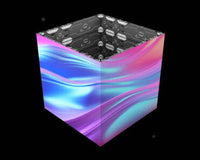The Crestron’s Automate™ VX solution is a superior speaker tracking system for larger rooms such as boardrooms, classrooms, and training spaces
It used to be that meeting room designers considered two things when choosing microphones for a project. Is the mic suitable for the overall aesthetic of the space as well as providing the best audio quality? Also, which mic will work best with a camera tracking solution that targets a specific speaker in a meeting space?
With Crestron's Automate VX solution, you can track speakers in larger rooms, such as boardrooms and classrooms. “Using these solutions, cameras can be switched and aimed at active talkers in a room by analyzing data from the microphones and room diagram to locate the active talker – or the region where the active talker is – automatically.” Rony Sebok, Crestron's director of intelligent video, explains.
Speaker tracking technology that seamlessly switches from person to person is superior to traditional "fixed camera shot" setups. A video camera system like this mimics the camera switching of a television production studio without the need for anyone to operate the cameras or switches. It is still important to pick the right mic for the right situation to achieve the best results.
The Five Types of Microphones
The following five types of microphones have distinct advantages (and typical use cases):
- The tabletop category includes goosenecks, button mics, and boundry.
- A lavalier microphone is sometimes called a lapel mic.
- Ceiling tile array microphones
- Discussion / panel microphone systems
- Pendant microphones
Tabletop Microphones
Panelists and podiums often use gooseneck microphones, says Sebok. Due to the mic's proximity to the person, they provide excellent audio for a single person."
As long as the mics are placed in a fixed or known location, they are perfect for camera-tracking systems. “The Automate VX camera system uses a DSP to determine which gooseneck mic someone is talking into and then uses a room diagram to determine where that mic is and aims a camera there,” says Sebok.
She adds that other tabletop microphones can be used similarly, framing a person speaking in a single shot. “For example, button mics are discrete and provide a camera tracking system with useful information about who is speaking.”
The Shure® MXA310 microphone can also be used as an intelligent table array microphone, according to Cara Shannon, Crestron senior manager of product marketing. The “hockey puck” style units have multiple microphone elements that are adjustable for a defined area of coverage. Each mic element can be used to provide additional camera tracking positions in the room.
Ceiling Tile Microphones
Ceiling tile mics are gaining popularity because, as their name implies, they are highly unobtrusive — they don't take up table space — but they cover a large area. With beamforming technology, these mics can effectively cover a 25 by 25-foot area while "reporting" where a beam is aimed to pick up a speaker. A room that doesn't have fixed furniture can also accommodate different configurations easily when using them.
According to Sebok, Automate VX can identify which person in the room is speaking based on the beam direction and a room diagram. The Automate VX system delivers “tighter” shots than competing solutions, which often only target a zone rather than individual speakers with beamforming ceiling mics. “One, two, or three-person shots are possible.”
Lavalier Microphones
A lavalier mic is also a single-person mic, which is often used by lecturers who move around. “With face detection and motion tracking, the 1 Beyond AutoTrackerTM camera is a great solution for presenter spaces.” When incorporated into an Automate VX system, the audio DSP identifies the lavalier mic as the active talker, and can select the AutoTracker camera automatically, further improving the experience.
“A combination of audio location and face/motion tracking is extremely powerful,” she adds.
Discussion Systems
A discussion system is most commonly used in large assembly halls, where there can be up to 250 microphones in one room, says Sebok. In addition to having built-in speakers that allow people far away from one another to still be heard, they often have features that allow them to vote or to identify people by their seating.
This solution can be wired or wireless and includes a control system that reports which microphone (or microphones) are active at any given time.
It is common for individual mics to have two modes: push-to-talk and voice-activated. Push-to-talk mics automatically activate when the user pushes the button, no matter how quiet they are. As a result of the button's trigger, the camera tracking solution will aim the camera accordingly. While this works well for organized meetings, it doesn't work so well for ad hoc discussions. Therefore, voice-activated camera tracking solutions are preferred.
Pendant Microphones
Despite their popularity, pendant mics can be troublesome for camera tracking systems. "Since their coverage area is often so wide, the system has difficulty tracking the speaker," says Sebok.
She adds that when an audio system uses auto-gain, it's even harder to distinguish which mic a person is closest to.
According to Sebok, pendant mics aren't a great choice as a result. "There are also other types to best implement with an intelligent video system while meeting the acoustical and architectural requirements of the room." The integrator who knows what he's doing can easily find the right acoustical and architectural fit for a room."
“Creation Networks is always available to provide more specific guidance and design assistance to ensure the best outcome.” Contact us today
SUBSCRIBE TO OUR NEWSLETTER
Recieve our latest weekly releases, offers, guides and more.







